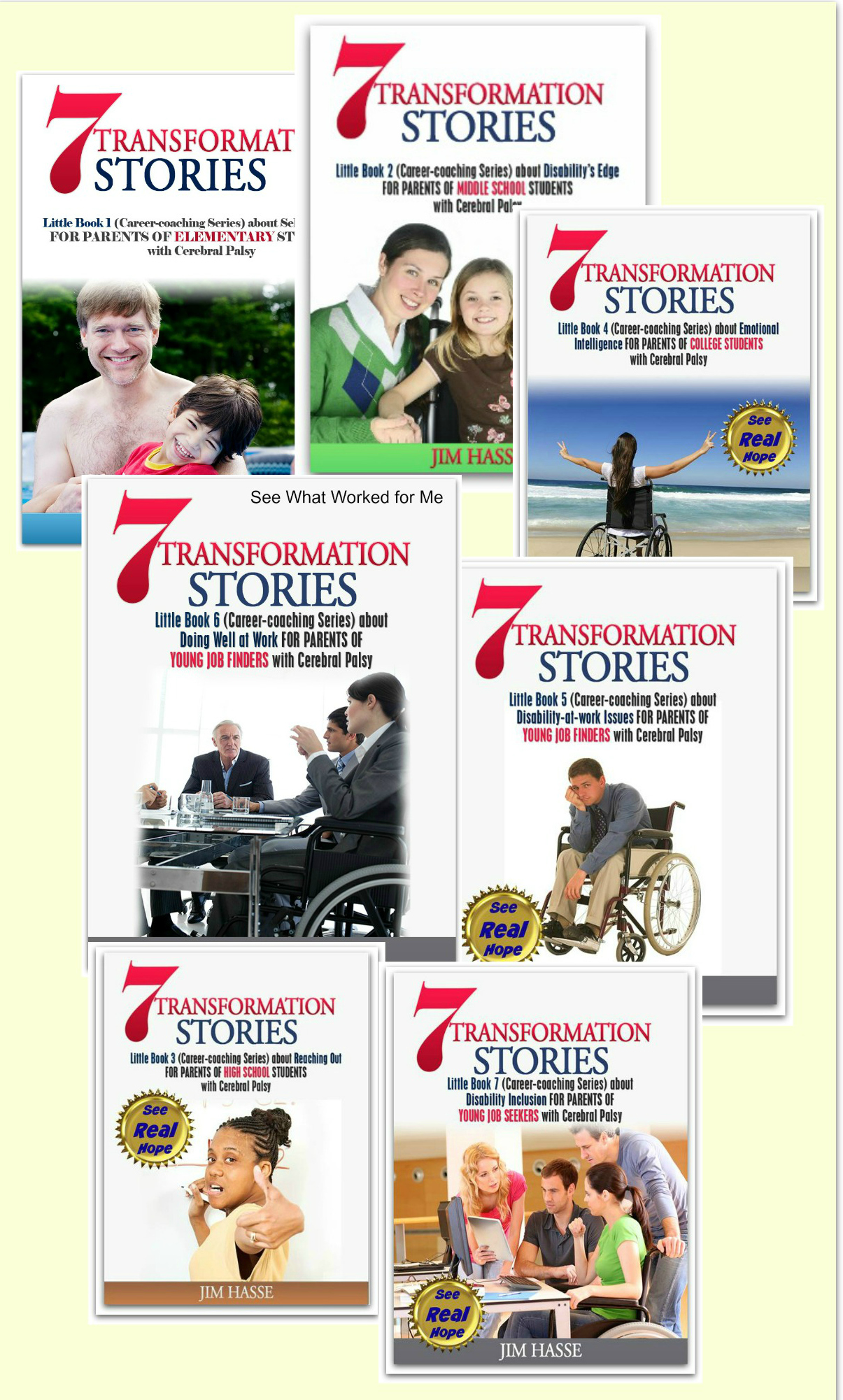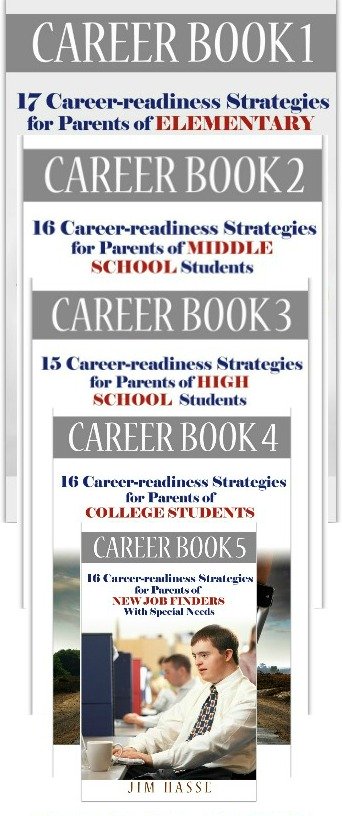Basic Interpersonal Communication:
Cerebral Palsy Middle School Career
Builder
By Jim Hasse, ABC, GCDF, Disability Employment Expert
_________________________________________________________
Effective job interviewing is basic interpersonal communication.
But, job interviews nowadays can be, at times, weird -- at least from a middle school student’s perspective.
Today’s job seekers need to be prepared to reply succinctly to straight-forward questions about their experience as well as to take advantage of more creative approaches, such as requests to:
- “Cite an example of when you felt you were illustrating
your ‘emotional intelligence’ in a work setting.”
- Or, “Tell a story about yourself that illustrates your
ability to build effective interpersonal relationships on the job.”
- Or, “Describe how you have successfully handled a difficult
work situation that really presented you with a personal challenge. How
did that situation change your perception of what you can accomplish? Why
do you feel good about the outcome?”
Yuk, right? And, by the time your junior high school student with cerebral palsy becomes a job seeker, who knows what the latest trend in job interviewing will be?
But, don’t despair. Those types of questions give job seekers an unusual opportunity to showcase their true colors by telling short but powerful stories about themselves -- stories which can make them stand-out candidates who have acquired basic interpersonal communication skills.
Personal short stories which illustrate a job candidate’s qualifications have always been powerful – and that will most likely still be the case 10 years from now when your youngster will be hitting the job market.
That may seem like a long way off, but the time to be thinking about how your youngster can practice basic interpersonal communication skills is now.
Which stories are appropriate for a job interview? Think of the attributes most employers today seek in a job candidate. Here are six of the qualities I hear most often from the “wish list” of employers when they think of their “ideal” job candidate: focus and stretch, perspective and communication, curiosity and creativity.
That’s your heads up for practicing basic interpersonal communication with your youngster who has CP and for role playing how he or she would describe already-accumulated experience which matches what employers have always sought in job applicants.
Let’s look at the six employer-preferred attributes I mention above and how I would present three anecdotes from my own functional experience to address those employer needs. I want to give you a picture of what’s ahead (in terms of showcasing opportunities for your youngster).

Focus and Stretch
Attribute Definitions:
Focus is inhibiting your initial response to achieve a larger goal. Your youngster needs to determine (and pay attention to) what is important amid many distractions in today’s complicated world. The ability to focus may be as important as intelligence in determining success in the workplace.
Stretch is the willingness to take on challenges. Does your youngster see capabilities as fixed traits and, as a result, display a reluctance to undertake challenges that stretch them? Or, are abilities attributes that can be developed? Is your youngster proactive instead of reactive when difficulties arise?
Does your youngster feel adequate in terms of temperament and motivation to meet the demands, expectations and opportunities offered by others?
Personal Anecdote About Basic Interpersonal Communication:
Between 1999 and 2009, I maintained a strict work-at-home schedule during a decade of collaborating with 10 different freelancers located throughout North America. I was located in Wisconsin. Our home office was in Manhattan, New York City. Together (on a rotating basis with at least three of us working together at any one time), we researched, wrote and edited more than 1,200 articles about disability employment issues.
As senior content developer, I spearheaded the effort to write three solid articles a week, publishing them on our web site and highlighting them in a weekly newsletter, which we distributed each Wednesday to a growing list of subscribers.
It was a challenge for all of us in
terms of time, research, creativity and accuracy, but we consistently met that
goal because we believed the content we were producing was important and that
it would help build traffic to our site.
When has your youngster shown
skill
in dealing well with others?
Join PACER’s Facebook
discussion.
Perspective and Communication
Attribute Definitions:
Is your youngster able to understand another’s perspective, despite whether he or she ends up agreeing or disagreeing with that individual? If so, you may see the foundation forming in your youngster for knowing how to deal with conflict. That skill may also be helpful in seeing things as a customer would see them and understand what’s going on in their minds.
In terms of interpersonal communication, is your youngster able to inhibit a personal point of view (listen first) to understand the viewpoints of others?
Personal Anecdote About Basic Interpersonal Communication:
Between 1978 and 1993, I helped senior management plan and execute the communication strategies for 15 mergers and acquisitions -- strategies based on how I perceived stockholders, employees and customers would think about and react to changes which would affect their livelihoods.
By working with senior management to align 3,000 new dairy farmer members, 300 new employees, 80 new truckers and 40 new customers with our organization’s vision, values and direction, I helped our organization become the surviving (and thriving) company in a major restructuring of the Midwest dairy industry.
I learned that my key responsibility was to ask questions, gather opinions and summarize my findings for senior management so it could effectively guide the organization with authenticity.
As a listener, it didn’t matter so much what I personally thought -- until I put on my hat as a communication counselor/advisor to the CEO and my colleagues at the vice presidential level.
Curiosity and Creativity
Attribute Definitions:
Is your youngster engaged in self-directed learning? Is he or she interested, curious and motivated by a certain topic?
Through curiosity, he or she may make connections between two or more divergent concepts or objects. That’s the basis of creativity. Kathy Hirsh-Pasek, a professor of psychology at Temple University and the co-author of “Einstein Never Used Flashcards” and “A Mandate for Playful Learning in Preschool,” says:
“In a Google generation, where there are facts at your fingertips, the person who will later be your boss will be the person who can put those facts together in new and innovative and creative ways.”
However, to be meaningfully creative, your youngster also needs to exercise critical thinking – to objectively evaluate his or her “new creation” in terms of usefulness, effectiveness, and practicality.
“Critical thinking is the ongoing
search for valid and reliable knowledge to guide our beliefs and actions.
Reflection results in and makes critical thinking possible,” writes Ellen
Galinsky in “Mind in the Making: The Seven Essential Life Skills Every
Child Needs” (Harperstudio, 2010).
Personal Anecdote About Basic Interpersonal Communication:
In 1997, long before Web 2.0, I was online as an entrepreneur, fulfilling my dream of tapping the unique capability of the Internet to bring people, regardless of their location, together to discuss issues that were important to them. I was providing individuals who had a disability with the first-ever tools they needed to share their personal-experience stories through my personal web site, tell-us-your-story.com, the forerunner of today’s blogging phenomenon. My site eventually contained more than 1,000 entries from around the globe.
It all started when, out of curiosity, I took a course about a “new communication tool” called the Internet at the University of Wisconsin-Madison in 1994. I remember sitting in that class and realizing I wanted to somehow use the Internet to provide an online gathering place for people with disabilities.
In each of these stories, notice how I describe the opportunity/challenge I faced, how I was personally involved, and the concrete results of the initiative. From a job interviewer’s perspective, that’s basic interpersonal communication.
Help your middle school student practice telling his or her success stories to family members and friends. Some of those stories may become powerful job marketing tools 10 years from now, all stemming from basic interpersonal communication skills honed in junior high.
When has your youngster shown
skill
in dealing well with others?
Join PACER’s Facebook
discussion.
Return from Basic Interpersonal Communication to Career Test
Go to Cerebral Palsy Career Builders
This is Creative Commons content. You can freely and legally use, share and repurpose it for non-commercial purposes only, provided you attach this sentence and the following attribution to it (including the two links):
Originally written and illustrated by Jim Hasse, ABC, GCDF, owner of Hasse Communication Counseling, LLC, who, as a person with cerebral palsy, served for 10 years as a vice president in a Fortune 500 company during his 29-year career in corporate communication. He’s an Accredited Business Communicator, certified as a Global Career Development Facilitator and author of 14 Amazon books about disability awareness and disability employment issues.





